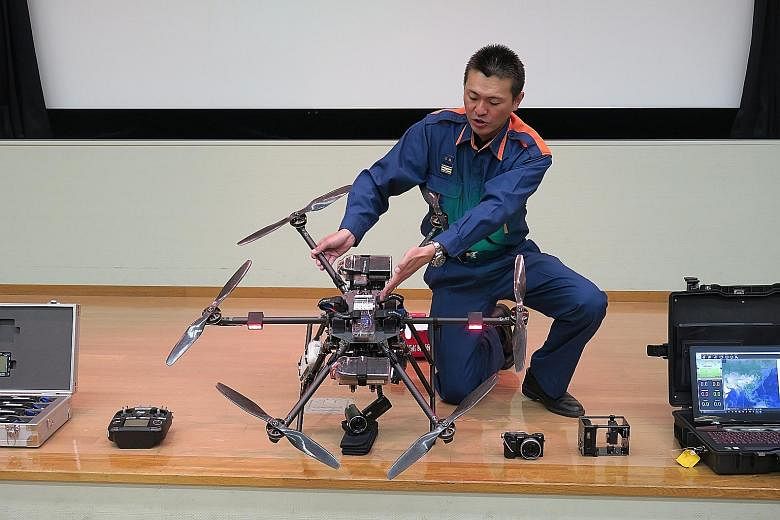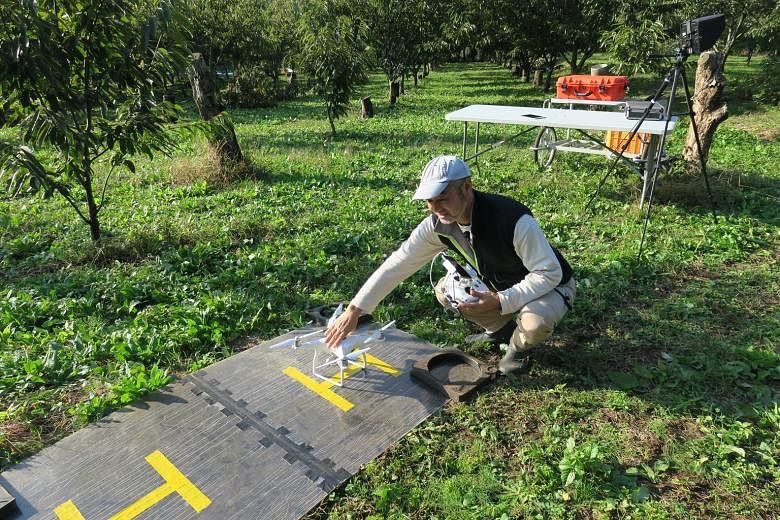A drone hovers over a disaster zone, feeding live information to emergency responders who can then plot a rescue route.
Such is the way forward for disaster-prone Japan, where the Chiba City Fire Department last month became one of the first in the country to be able to tap unmanned aerial vehicle (UAV) technology for its operations.
While the department has not received any cases that require the use of the drone so far, its assistant commander Takayuki Mitsui said his team is "fully prepared".
"We feel the unmanned reconnaissance system will change the future of fire-fighting operations," he said at a recent interview. He noted such dangerous scenarios as forest fires, tsunamis, landslides and earthquakes where UAVs could mitigate the risk for fire-fighters while also pointing them to survivors.
Its drone, acquired by the national Fire and Disaster Management Agency for 2.5 million yen (about S$31,500), can be fitted with a camera or a gas sensor, allowing responders to see live footage of a disaster scene and test the concentration of gases in the air.
It can fly for up to 20 minutes and 18km each time and, by default, will return to its take-off location if the geolocation system is weak or the battery runs low.
Mr Mitsui said his team, which has been training to use drones since May, will also be deployed to support colleagues elsewhere in the country in the event of a disaster.
On Kyushu island in south Japan, trials started in August in which medics flew medicine, defibrillators and supplies to areas relatively inaccessble by land transport.
Project leader Yusuke Enjoji, an official in the Saga prefectural government, was reported as saying: "Drones add more options for rescuers to reach patients."
For instance, if an automated external defibrillator can be sent by drone together with instructions on how to use it, a bystander may be able to render aid quickly while waiting for paramedics to arrive, he said.
In Singapore, public agencies have also tapped the use of drones with PUB and the National Environment Agency (NEA) conducting trials. The PUB is considering using drones to monitor reservoirs; and the NEA, potential mosquito breeding sites. Singapore's Police Coast Guard is also planning to tap UAVs for the surveillance of surrounding waters.
Both Singapore and Japan have strict rules on the technology - Japan revised its laws last year after a drone was found on the roof of the Prime Minister's Office building.
But laws have been relaxed in Chiba city - an hour to the east of Tokyo - seen as a testbed for the widespread use of drone technology.
Chiba wants to make drone deliveries a reality by 2019. In April, it succeeded in delivering a bottle of wine from a supermarket to an apartment.
"We want to get a head start in the building of a future-oriented community and disseminate the idea to the rest of the world," Chiba mayor Toshihito Kumagai said last month.
The city's use of drones also extends to more traditional industries such as agriculture.
Mr Akihito Takahashi, 54, is the third-generation owner of Takahashi Pear Farm, which has 200 pear trees. He runs the farm alone for the most part, giving up his 25 years in the IT industry to take over the family business five years ago.
Due to the "demanding and laborious" work, he chose to tap his experience in technology to find ways around the labour shortage and to modernise the work.
He started using drones two years ago, which he said allows him to monitor the growth of his crops and discover any irregularities.
The man leading Chiba's drone effort is Dr Kenzo Nonami, an emeritus professor at Chiba University who also runs a 50-man start-up.
He envisions future drones to be able to fly for more than an hour and be equipped with a "parachuting" function so it can drop gently to the ground in the event of a mishap.
And, within 10 years, he foresees large UAVs being able to airlift victims of road accidents, heart attacks or diseases, to the hospital.
With unmanned cars today, he told The Straits Times that it would not require too huge a leap of imagination.


